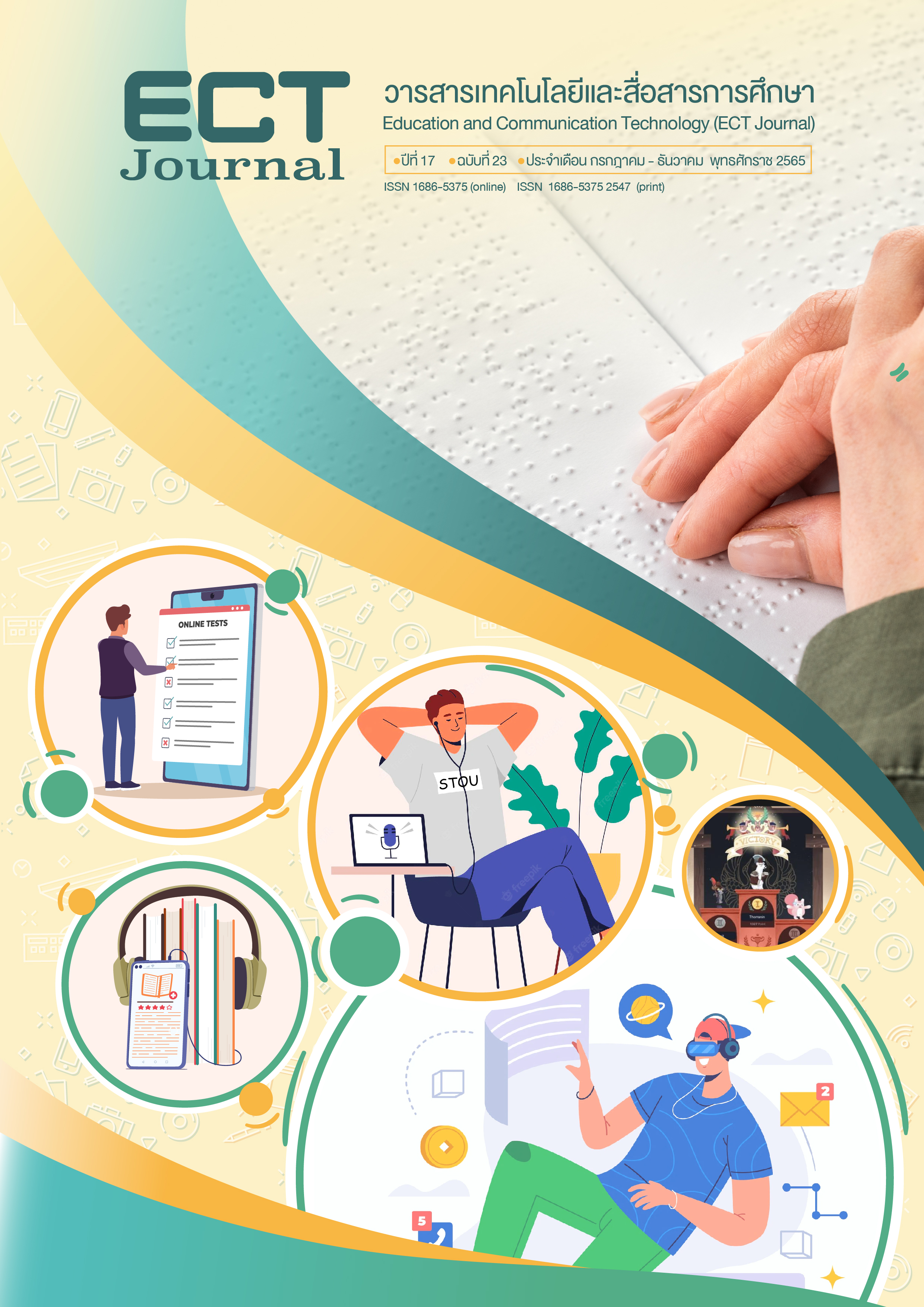Development of Game Based Micro-learning in Online Active Learning for Student Teachers
Keywords:
micro-learning, active learning, game based micro-learningAbstract
The objectives of this research were to 1) develop active learning by game based micro-learning, 2) study the learning achievement of student teachers who studied through active learning by game based micro-learning, and 3) study the satisfaction of the student teachers who studied through active learning by game based micro-learning. This pre-experimental design was one group pre-test post-test only design. The samples were 155 student teachers from the faculty of Education, Rajamangala University of Technology Thanyaburi. The research instruments composed of active learning by game based micro-learning, and evaluation form of satisfaction. Data was analyzed by percentage, mean, standard deviation and t-test for dependent samples.
The research was revealed that: 1) the quality of active learning by game based micro-learning was at the level of “very good” (M = 4.54, S.D. = 0.65), 2) the post-test score of the student teachers who studied through active learning by game based micro-learning was significantly higher than the pre-test score at level, and 3) the satisfaction of the student teachers who studied through active learning by game based micro-learning was at “most” level (M = 4.52, S.D. = 0.62)
References
เกรียงไกร ลิ่มทอง. (2560, 22 มิถุนายน). การประยุกต์ใช้รูปแบบกิจกรรมผ่านเกมส์สำหรับการเข้าชั้นเรียนและการมีส่วนร่วมในชั้นเรียน: กรณีศึกษานักศึกษาภาควิชาวิศวกรรมคอมพิวเตอร์ มหาวิทยาลัยกรุงเทพ. ใน การประชุมหาดใหญ่วิชาการระดับชาติและนานาชาติ ครั้งที่ 8.(น. 72-82). มหาวิทยาลัยหาดใหญ่.
ชญานิษฐ์ นกแก้ว. (2564, 4 มีนาคม). 'วอนเดอร์' เอดเทคสตาร์ทอัพ ส่งเกมมิฟิเคชั่น สร้างการเรียนรู้ให้สนุก!. Bangkok Biznews. https://www.bangkokbiznews.com/tech/925372
ธารีย์ณิชา ลีพีรวิทิตกว้าน, สีตะธนี, และวิเชียร ชุติมาสกุล. (2560). การเพิ่มประสิทธิผลการเรียนรู้ของเจนเนอเรชันแซดผ่านการเรียนรู้แบบไมโคร. https://webapp1.sit.kmutt.ac.th/risp/acstract/2017/2017012.xml
พิศมัย หาญมงคลพิพัฒน์. (2561, 20 กรกฎาคม). การจัดการเรียนการสอนในรูปแบบเกม. ใน การประชุมหาดใหญ่วิชาการระดับชาติและนานาชาติ ครั้งที่ 9. (น. 1129-1128). มหาวิทยาลัยหาดใหญ่.
วัลภา คงพัวะ. (2562). ความพึงพอใจที่มีต่อการใช้ KAHOOT! ในการจัดการเรียนรู้ของนักศึกษาระดับปริญญาตรี สาขาวิชาการจัดการ มหาวิทยาลัยนอร์ทกรุงเทพ ศูนย์การศึกษานนทบุรี. วารสารสมาคมสถาบันอุดมศึกษาเอกชนแห่งประเทศไทย, 25(1), 114-132. https://so06.tci-thaijo.org/index.php/edu-rmu/article/view/253999
อาทิตยา ไสยพร. (2564, 29 ธันวาคม). ให้คะแนนอย่างไร หากไม่มีการสอบ. Educathai. https://www.educathai.com/knowledge/articles/555
Gona, S. M., Karzan, W. S., & Sirwan, N. (2018). The effectiveness of microlearning to improve students' learning ability. International Journal of Educational Research Review, 3(3), 32-38. https://doi.org/10.24331/ijere.415824
Goknur, K., & Kursat, C. (2006). An instructional design/development model for the creation of game-like learning environments: The FIDGE Mode. ResearchGate. https://www.researchgate.net/publication/266073748
Lise, M. (2018). Tracking active learning in the medical school curriculum: A learning-centered approach. Journal of Medical Education and Curricular Development, 5, 1-4. https://doi.org/10.1177/2382120518765135
Sergiy, M. (2020, January 24). What is game-based microlearning? Raccoon Gang. https://raccoongang.com/blog/what-game-based-microlearning/
Downloads
Published
Versions
- 2022-11-19 (2)
- 2022-11-18 (1)
How to Cite
Issue
Section
License
Copyright (c) 2022 มหาวิทยาลัยสุโขทัยธรรมาธิราช

This work is licensed under a Creative Commons Attribution-NonCommercial-NoDerivatives 4.0 International License.
1. ทรรศนะและข้อคิดเห็นใด ๆ ที่ปรากฏอยู่ในวารสาร ECT Education and Communication Technology Journal เป็นของผู้เขียนโดยเฉพาะ สำนักเทคโนโลยีการศึกษา มหาวิทยาลัยสุโขทัยธรรมาธิราช และกองบรรณาธิการไม่จำเป็นต้องเห็นพ้องด้วย
2. กองบรรณาธิการของสงวนลิขสิทธิ์ในการบรรณาธิการข้อเขียนทุกชิ้น เพื่อความเหมาะสมในการจัดพิมพ์เผยแพร่






